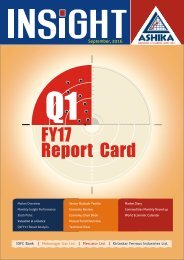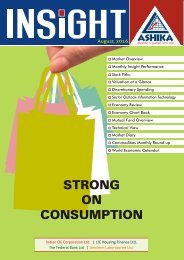Ashika Monthly Insight August 2016
Create successful ePaper yourself
Turn your PDF publications into a flip-book with our unique Google optimized e-Paper software.
STRONG ON CONSUMPTION<br />
DISCRETIONARY SPENDING<br />
Discretionary spending has strong correlation with the<br />
economic development as the individuals trends to spend<br />
more when his disposable income increase. Individual’s<br />
priority is to fulfill its basic needs and after that any<br />
residual incremental income is used to spend/invest in<br />
purchasing homes, cars, luxury items and precious metals<br />
based on their discretion. Government’s fiscal stimulus to<br />
spur economic growth by way of recommending and<br />
approving 7th Pay commission (PC) should increase the<br />
demand for owning cars, homes and luxury items. The<br />
increase in public sector wages and pensions should<br />
boost urban discretionary demand, particularly for<br />
durables such as automobiles and smaller-ticket items<br />
like clothing and footwear and recreation services.<br />
However, the impact of 6th PC had been robust owing to<br />
higher percentage hike in wages and salary and 3 years<br />
arrears as compared to 3 months arrears approved in 7th<br />
PC. Implementation of the sixth pay commission led to a<br />
rise in consumption expenditure on automobiles of more<br />
than 20% the following year, compared with 7.4% yoy in<br />
the year prior. Taking cues from previous pay commission,<br />
it boosted consumer discretionary demand, pushed up<br />
CPI inflation and increased the government’s fiscal<br />
burden. Providing fiscal stimulus by ohiking wages of<br />
central government employee also distrted the fiscal<br />
balances of the government. For example, 6th PC, which<br />
w a s i m p l e m e n t e d i n F Y 0 9 , raised t h e ce n t ral<br />
government’s wage and pension bill from 2.0% of GDP in<br />
FY08 to 2.7% in FY09 and further elevated to 3.3% in<br />
FY10. Its impact was felt for two years as the government<br />
staggered the payment of arrears accumulated owing to<br />
its delayed implementation. Combined with a slowdown<br />
in tax revenue caused by the global financial crisis, this<br />
pushed up the fiscal deficit from 2.5% of GDP in FY08 to<br />
over 6% in the subsequent two years. There was a similar<br />
impact during the implementation of the Fifth Pay<br />
Commission. Therefore the pay hikes should provide a<br />
boost to growth, partly offsetting the growing downside<br />
risks from slower global demand and still-weak private<br />
sector investment. This year monsoon would play a big<br />
role in spurting consumer demand after two consecutive<br />
year of drought. Well spread monsoon across the country<br />
would increase the productivity of rural areas, resulting in<br />
improvement in purchasing power of rural people. The<br />
demand for passenger vehicles, two wheelers, tractors,<br />
home appliances and consumer staples are directly<br />
correlated with the progress of monsoon during this year.<br />
Implementation of GST from next financial year would<br />
unlock the economic value which is concealed due to<br />
current complexity of indirect tax structure. GST bill which<br />
is seeking passage in Rajya Sabha would play a vital role<br />
in economic growth as it would simplify the current<br />
complex indirect tax structure and bring the unorganized<br />
sector under tax purview. The Centre has been pushing<br />
hard to build a consensus on the legislation so that it can<br />
finally be passed in the ongoing monsoon session of<br />
Parliament. Eventually, the implementation of GST would<br />
create a uniform tax rate which could support the growth<br />
of consumer demand going ahead. 7th Pay commission,<br />
good monsoon, effect of GST and rising middle class are<br />
the main catalysts that would drive the discretionary<br />
spending, resulting in strong demand for Auto, Real estate,<br />
Consumer durable goods and Retail Finance sectors.<br />
Rising middle class income will give discretionary<br />
spending power to people<br />
India accounts for 3% of the global middle class with 23.6<br />
million people. A report from Credit Suisse “Global Wealth<br />
Report 2015” stated that there are 664 million adults<br />
belonging to the global middle class in 2015, or 14% of<br />
the adult population, where India has 23.6 million adults<br />
who qualified as middle class in 2015. The growth of<br />
wealth has been the fastest in India (second only to China)<br />
over 15 years (2000-2015). India added 6.7 million adults<br />
to the middle class over these 15 years, and middle-class<br />
21






